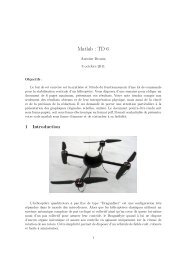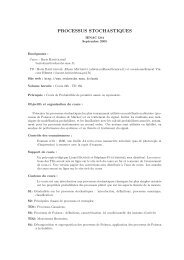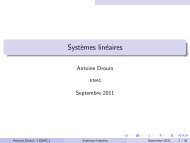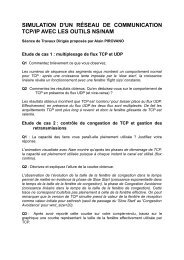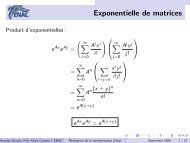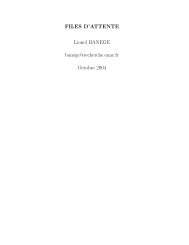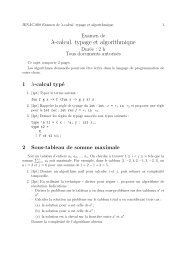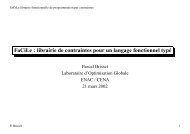Stabilité des système dynamiques, Commande par retour d'état
Stabilité des système dynamiques, Commande par retour d'état
Stabilité des système dynamiques, Commande par retour d'état
Create successful ePaper yourself
Turn your PDF publications into a flip-book with our unique Google optimized e-Paper software.
<strong>Stabilité</strong> <strong>des</strong> <strong>système</strong> <strong>dynamiques</strong>, <strong>Commande</strong> <strong>par</strong> <strong>retour</strong><br />
d’état<br />
Antoine Drouin<br />
ENAC<br />
21 septembre 2011<br />
Antoine Drouin ( ENAC )<br />
<strong>Stabilité</strong> <strong>des</strong> <strong>système</strong> <strong>dynamiques</strong>, <strong>Commande</strong> <strong>par</strong> <strong>retour</strong> d’état 21 septembre 2011 1 / 28
1 <strong>Stabilité</strong> : Définitions générales<br />
2 <strong>Stabilité</strong> <strong>des</strong> <strong>système</strong> LTI<br />
3 <strong>Commande</strong> <strong>par</strong> <strong>retour</strong> d’état<br />
Antoine Drouin ( ENAC )<br />
<strong>Stabilité</strong> <strong>des</strong> <strong>système</strong> <strong>dynamiques</strong>, <strong>Commande</strong> <strong>par</strong> <strong>retour</strong> d’état 21 septembre 2011 2 / 28
<strong>Stabilité</strong> : Définitions générales<br />
<strong>Stabilité</strong><br />
Définition<br />
Un <strong>système</strong> est dit stable autour d’un point d’équilibre si lorsque de faibles<br />
perturbations sont appliquées, il reste au voisinage de ce point.<br />
Remarque<br />
Le point d’équilibre est un état d’équilibre ou une trajectoire de son<br />
vecteur d’état.<br />
Antoine Drouin ( ENAC )<br />
<strong>Stabilité</strong> <strong>des</strong> <strong>système</strong> <strong>dynamiques</strong>, <strong>Commande</strong> <strong>par</strong> <strong>retour</strong> d’état 21 septembre 2011 3 / 28
<strong>Stabilité</strong> : Définitions générales<br />
État d’équilibre<br />
Soit un <strong>système</strong> dynamique défini <strong>par</strong> une représentation d’état<br />
Ẋ = f (X , U)<br />
État d’équilibre X e<br />
˙ X e = f (X e , 0) = 0<br />
∀t<br />
Trajectoire de référence X r (t), U r (t)<br />
∀t,<br />
f (X r (t), U r (t)) = Ẋ r (t)<br />
Antoine Drouin ( ENAC )<br />
<strong>Stabilité</strong> <strong>des</strong> <strong>système</strong> <strong>dynamiques</strong>, <strong>Commande</strong> <strong>par</strong> <strong>retour</strong> d’état 21 septembre 2011 4 / 28
<strong>Stabilité</strong> : Définitions générales<br />
État d’équilibre : Exemples<br />
Masse-Ressort<br />
( 0 1<br />
Ẋ =<br />
−K<br />
m<br />
−f<br />
m<br />
) ) 0<br />
X +(<br />
1 U<br />
m<br />
Pendule<br />
( )<br />
˙θ<br />
Ẋ (t) = f (X , U) =<br />
− g l<br />
sin(θ)<br />
Antoine Drouin ( ENAC )<br />
<strong>Stabilité</strong> <strong>des</strong> <strong>système</strong> <strong>dynamiques</strong>, <strong>Commande</strong> <strong>par</strong> <strong>retour</strong> d’état 21 septembre 2011 5 / 28
<strong>Stabilité</strong> : Définitions générales<br />
Trajectoire de référence : Exemple<br />
Satellite<br />
Représentation d’état<br />
⎛ ⎞<br />
θ<br />
X = ⎜<br />
r<br />
⎟<br />
⎝ ˙θ ⎠<br />
ṙ<br />
⎛<br />
⎞<br />
˙θ<br />
ṙ<br />
Ẋ (t) = f (X , U) = ⎜ 2ṙ ˙θ<br />
⎝ −<br />
r<br />
+ u ⎟<br />
θ<br />
r<br />
⎠<br />
r ˙θ 2 − β + u<br />
r 2 r<br />
Trajectoire de référence<br />
( 0<br />
U ref (t) =<br />
0)<br />
⎛<br />
X ref (t) =<br />
⎜<br />
⎝<br />
√<br />
β<br />
r 3 0<br />
⎞<br />
t + θ 0<br />
√<br />
r 0<br />
β ⎟<br />
r0<br />
3 ⎠<br />
0<br />
Antoine Drouin ( ENAC )<br />
<strong>Stabilité</strong> <strong>des</strong> <strong>système</strong> <strong>dynamiques</strong>, <strong>Commande</strong> <strong>par</strong> <strong>retour</strong> d’état 21 septembre 2011 6 / 28
<strong>Stabilité</strong> : Définitions générales<br />
État d’équilibre : cas LTI<br />
Théorème<br />
Un <strong>système</strong> LTI de matrice de dynamique A posséde :<br />
un point d’équilibre ( X = 0 n ) si A est inversible.<br />
une infinité de points d’équilibre ( le noyau de A) si A n’est pas<br />
inversible.<br />
Exemple : Masse-Ressort<br />
( 0 1<br />
Ẋ =<br />
−K<br />
m<br />
−f<br />
m<br />
) ) 0<br />
X +(<br />
1 U<br />
m<br />
un point d’équilibre si K ≠ 0<br />
une infinité de points d’équilibre si K = 0<br />
Antoine Drouin ( ENAC )<br />
<strong>Stabilité</strong> <strong>des</strong> <strong>système</strong> <strong>dynamiques</strong>, <strong>Commande</strong> <strong>par</strong> <strong>retour</strong> d’état 21 septembre 2011 7 / 28
<strong>Stabilité</strong> : Définitions générales<br />
<strong>Stabilité</strong> EBSB (BIBO)<br />
Définition<br />
Un <strong>système</strong> est dit stable vis à vis de ses comman<strong>des</strong> ( entrées bornées,<br />
sorties bornées) si à toute entrée bornée, correspond une sortie bornée.<br />
∀t 0 , ∀ɛ, ∃η : |U(t)| < η, ∀t > t 0 ⇒ |Y (t)| < ɛ, ∀t > t 0<br />
Antoine Drouin ( ENAC )<br />
<strong>Stabilité</strong> <strong>des</strong> <strong>système</strong> <strong>dynamiques</strong>, <strong>Commande</strong> <strong>par</strong> <strong>retour</strong> d’état 21 septembre 2011 8 / 28
<strong>Stabilité</strong> : Définitions générales<br />
<strong>Stabilité</strong> au sens de Lyapunov<br />
Définition<br />
Un état d’équilibre X e est stable si<br />
∀t 0 , ∀ɛ > 0, ∃η > 0 : |X (t 0 ) − X e | < η ⇒ |X (t) − X e | < ɛ, ∀t ≥ t 0<br />
Définition<br />
Un <strong>système</strong> est stable si tous ses points d’équilibre le sont<br />
Antoine Drouin ( ENAC )<br />
<strong>Stabilité</strong> <strong>des</strong> <strong>système</strong> <strong>dynamiques</strong>, <strong>Commande</strong> <strong>par</strong> <strong>retour</strong> d’état 21 septembre 2011 9 / 28
<strong>Stabilité</strong> : Définitions générales<br />
<strong>Stabilité</strong> asymptotique<br />
Définition<br />
Un état d’équilibre X e est asymptotiquement stable s’il est stable au sens<br />
de Lyapunov, et si<br />
∃η,<br />
|X (t 0 ) − X e | < η ⇒ lim<br />
t→∞<br />
|X (t) − X e | = 0<br />
<strong>Stabilité</strong> exponentielle<br />
Un état d’équilibre X e est exponentiellemnt stable s’il est stable au sens de<br />
Lyapunov, et si<br />
∃η, ∃α > 0, ∃β > 0<br />
|X (t 0 ) − X e | < η ⇒ |X (t) − X e | < αe −βt<br />
Antoine Drouin ( ENAC )<br />
<strong>Stabilité</strong> <strong>des</strong> <strong>système</strong> <strong>dynamiques</strong>, <strong>Commande</strong> <strong>par</strong> <strong>retour</strong> 21 d’état septembre 2011 10 / 28
<strong>Stabilité</strong> : Définitions générales<br />
Illustration<br />
Antoine Drouin ( ENAC )<br />
<strong>Stabilité</strong> <strong>des</strong> <strong>système</strong> <strong>dynamiques</strong>, <strong>Commande</strong> <strong>par</strong> <strong>retour</strong> 21 d’état septembre 2011 11 / 28
<strong>Stabilité</strong> : Définitions générales<br />
Méthode de Lyapunov<br />
Principe<br />
Si l’énergie totale d’un <strong>système</strong> est dissipée de manière continue, alors le<br />
<strong>système</strong> devra rejoindre un point d’équilibre.<br />
Méthode<br />
Générer pour le <strong>système</strong> une fonction scalaire “de type” énergie et en<br />
examiner la dérivée temporelle.<br />
Intéret<br />
Permet de conclure sur la stabilité d’un <strong>système</strong> sans résoudre<br />
explicitement les équations différentielles ( non linéaires).<br />
Antoine Drouin ( ENAC )<br />
<strong>Stabilité</strong> <strong>des</strong> <strong>système</strong> <strong>dynamiques</strong>, <strong>Commande</strong> <strong>par</strong> <strong>retour</strong> 21 d’état septembre 2011 12 / 28
<strong>Stabilité</strong> : Définitions générales<br />
Méthode de Lyapunov<br />
locale<br />
V (X e ) = 0<br />
V (X ) > 0, ∀X ≠ X e , X ∈ Ω<br />
˙V (X ) 0, ∀X ≠ X e , X ∈ Ω<br />
˙V (X ) < 0, ∀X ≠ X e , X ∈ Ω<br />
globale asymptotique<br />
V (X e ) = 0<br />
V (X ) > 0, ∀X ≠ X e<br />
˙V (X ) < 0, ∀X ≠ X e<br />
lim |X |→+∞ ˙V (X ) = −∞<br />
Antoine Drouin ( ENAC )<br />
<strong>Stabilité</strong> <strong>des</strong> <strong>système</strong> <strong>dynamiques</strong>, <strong>Commande</strong> <strong>par</strong> <strong>retour</strong> 21 d’état septembre 2011 13 / 28
<strong>Stabilité</strong> : Définitions générales<br />
Exemple<br />
Pendule<br />
( )<br />
˙θ<br />
Ẋ (t) = f (X , U) =<br />
− g l<br />
sin(θ)<br />
V (X ) = 1 2 ˙θ 2 + g (1 − cos(θ))<br />
l<br />
V (0) = 0,<br />
˙V (X ) = ˙θ¨θ + g l<br />
˙θsin(θ) = 0<br />
Le <strong>système</strong> est donc stable autour de l’origine.<br />
Antoine Drouin ( ENAC )<br />
<strong>Stabilité</strong> <strong>des</strong> <strong>système</strong> <strong>dynamiques</strong>, <strong>Commande</strong> <strong>par</strong> <strong>retour</strong> 21 d’état septembre 2011 14 / 28
<strong>Stabilité</strong> : Définitions générales<br />
Exemple<br />
Pendule amorti<br />
(<br />
)<br />
˙θ<br />
Ẋ (t) = f (X , U) =<br />
− g l<br />
sin(θ) − f | ˙θ| ˙θ<br />
V (X ) = 1 2 ˙θ 2 + g (1 − cos(θ))<br />
l<br />
V (0) = 0,<br />
˙V (X ) = ˙θ¨θ + g l<br />
˙θsin(θ) = −f ˙θ 2 | ˙θ| < 0<br />
Le <strong>système</strong> est donc asymptotiquement stable autour de l’origine.<br />
Antoine Drouin ( ENAC )<br />
<strong>Stabilité</strong> <strong>des</strong> <strong>système</strong> <strong>dynamiques</strong>, <strong>Commande</strong> <strong>par</strong> <strong>retour</strong> 21 d’état septembre 2011 15 / 28
<strong>Stabilité</strong> : Définitions générales<br />
Exemple<br />
S<br />
{<br />
x1 ˙ (t) = 2x 1 (x2 2 − 1)<br />
x˙<br />
2 (t) = −x 2 (x1 2 + 1)<br />
U 1 (x 1 , x 2 ) = x2 1 +x2 2<br />
2<br />
U˙<br />
1 (x 1 , x 2 ) = x 1 x˙<br />
1 + x 2 x˙<br />
2<br />
U˙<br />
1 (x 1 , x 2 ) = x1 2x 2 2−2x 1 2−x 2<br />
2<br />
U 2 (x 1 , x 2 ) = x2 1 +2x2 2<br />
2<br />
U˙<br />
2 (x 1 , x 2 ) = x 1 x˙<br />
1 + 2x 2 ˙<br />
U˙<br />
2 (x 1 , x 2 ) = −2x1 2 − 2x 2<br />
2<br />
x 2<br />
Antoine Drouin ( ENAC )<br />
<strong>Stabilité</strong> <strong>des</strong> <strong>système</strong> <strong>dynamiques</strong>, <strong>Commande</strong> <strong>par</strong> <strong>retour</strong> 21 d’état septembre 2011 16 / 28
<strong>Stabilité</strong> <strong>des</strong> <strong>système</strong> LTI<br />
Méthode de Lyapunov dans le cas LTI<br />
Antoine Drouin ( ENAC )<br />
<strong>Stabilité</strong> <strong>des</strong> <strong>système</strong> <strong>dynamiques</strong>, <strong>Commande</strong> <strong>par</strong> <strong>retour</strong> 21 d’état septembre 2011 17 / 28
<strong>Stabilité</strong> <strong>des</strong> <strong>système</strong> LTI<br />
<strong>Stabilité</strong> Asymptotique dans le cas LTI<br />
On a montré<br />
X (t) = e A(t−t 0) X (t 0 ) = Pe Λ(t−t 0) P −1 X (t 0 )<br />
CNS de stabilité asymptotique : Les racines du polynome<br />
caractéristique sont à <strong>par</strong>tie réelle négative<br />
Si une racine du polynome caractéristique est nulle non dégénérée, le<br />
<strong>système</strong> est stable, non asymptotiquement.<br />
Si une racine du polynome caractéristique est nulle et dégénérée, le<br />
<strong>système</strong> est instable.<br />
Antoine Drouin ( ENAC )<br />
<strong>Stabilité</strong> <strong>des</strong> <strong>système</strong> <strong>dynamiques</strong>, <strong>Commande</strong> <strong>par</strong> <strong>retour</strong> 21 d’état septembre 2011 18 / 28
<strong>Stabilité</strong> <strong>des</strong> <strong>système</strong> LTI<br />
<strong>Stabilité</strong> EBSB dans le cas LTI<br />
S stable EBSB ⇔<br />
∫ ∞<br />
0<br />
CΦ(t, τ)BU(τ)dτ < ∞<br />
Pour un <strong>système</strong> LTI, <strong>Stabilité</strong> Asymptotique ⇒ <strong>Stabilité</strong> EBSB<br />
( mais pas l’inverse )<br />
Antoine Drouin ( ENAC )<br />
<strong>Stabilité</strong> <strong>des</strong> <strong>système</strong> <strong>dynamiques</strong>, <strong>Commande</strong> <strong>par</strong> <strong>retour</strong> 21 d’état septembre 2011 19 / 28
<strong>Stabilité</strong> <strong>des</strong> <strong>système</strong> LTI<br />
Critère de Routh/Hurwitz<br />
P(λ) = a n λ n + a n−1 λ n−1 + · · · + a 1 λ + a 0<br />
Si un <strong>des</strong> coefficients est nul ou négatif alors qu’un autre au moins est<br />
positif, le polynome admet au moins une racine à <strong>par</strong>tie réelle positive.<br />
Si tous les coefficients sont positifs, on calcule le tableau de Routh<br />
(http ://en.wikipedia.org/wiki/Routh-Hurwitz stability criterion)<br />
Antoine Drouin ( ENAC )<br />
<strong>Stabilité</strong> <strong>des</strong> <strong>système</strong> <strong>dynamiques</strong>, <strong>Commande</strong> <strong>par</strong> <strong>retour</strong> 21 d’état septembre 2011 20 / 28
<strong>Commande</strong> <strong>par</strong> <strong>retour</strong> d’état<br />
Principe<br />
n∏<br />
P(λ) = (λ − λ k )<br />
k=1<br />
Antoine Drouin ( ENAC )<br />
<strong>Stabilité</strong> <strong>des</strong> <strong>système</strong> <strong>dynamiques</strong>, <strong>Commande</strong> <strong>par</strong> <strong>retour</strong> 21 d’état septembre 2011 21 / 28
<strong>Commande</strong> <strong>par</strong> <strong>retour</strong> d’état<br />
Principe<br />
n∏<br />
P(λ) = (λ − λ k )<br />
k=1<br />
Antoine Drouin ( ENAC )<br />
<strong>Stabilité</strong> <strong>des</strong> <strong>système</strong> <strong>dynamiques</strong>, <strong>Commande</strong> <strong>par</strong> <strong>retour</strong> 21 d’état septembre 2011 21 / 28
<strong>Commande</strong> <strong>par</strong> <strong>retour</strong> d’état<br />
Retour d’état<br />
Ẋ = AX + BU<br />
U = E − KX<br />
Ẋ = (A − BK)X + BE<br />
Antoine Drouin ( ENAC )<br />
<strong>Stabilité</strong> <strong>des</strong> <strong>système</strong> <strong>dynamiques</strong>, <strong>Commande</strong> <strong>par</strong> <strong>retour</strong> 21 d’état septembre 2011 22 / 28
<strong>Commande</strong> <strong>par</strong> <strong>retour</strong> d’état<br />
Retour d’état<br />
⎛<br />
⎞<br />
0 1 0 · · · · · · 0 ⎛ ⎞<br />
. . .. . .. . .. 0<br />
.<br />
.<br />
Ẋ =<br />
.<br />
.. . .. . .. 0<br />
.<br />
X +<br />
0<br />
.<br />
⎜ .<br />
.. . .. 0<br />
⎜0<br />
U<br />
⎟<br />
⎟ ⎝0⎠<br />
⎝ 0 · · · · · · · · · 0 1 ⎠<br />
1<br />
−a 0 −a 1 −a 2 · · · · · · −a n−1<br />
⎛<br />
⎞<br />
0 1 0 · · · · · · 0<br />
. .<br />
.. . .. . .. .<br />
.<br />
A−BK =<br />
.<br />
.. . .. . .. . .<br />
⎜ .<br />
.. . .. 0<br />
⎟<br />
⎝ 0 · · · · · · · · · 0 1 ⎠<br />
−(a 0 + k 0 ) −(a 1 + k 1 ) −(a 2 + k 2 ) · · · · · · −(a n−1 + k n−1 )<br />
Antoine Drouin ( ENAC )<br />
<strong>Stabilité</strong> <strong>des</strong> <strong>système</strong> <strong>dynamiques</strong>, <strong>Commande</strong> <strong>par</strong> <strong>retour</strong> 21 d’état septembre 2011 23 / 28
<strong>Commande</strong> <strong>par</strong> <strong>retour</strong> d’état<br />
Retour d’état<br />
Dynamique souhaitée<br />
d’ou ∀i,<br />
n∏<br />
n∑<br />
P(λ) = (λ − λ bk ) = b i λ i<br />
k=1<br />
i=0<br />
⎛<br />
⎞<br />
0 1 0 · · · · · · 0<br />
. . .. . .. . .. .<br />
. .<br />
.. . .. . .. .<br />
.<br />
⎜ .<br />
.. . .. 0<br />
⎟<br />
⎝ 0 · · · · · · · · · 0 1 ⎠<br />
−b 0 −b 1 −b 2 · · · · · · −b n−1<br />
k i = b i − a i<br />
Antoine Drouin ( ENAC )<br />
<strong>Stabilité</strong> <strong>des</strong> <strong>système</strong> <strong>dynamiques</strong>, <strong>Commande</strong> <strong>par</strong> <strong>retour</strong> 21 d’état septembre 2011 24 / 28
<strong>Commande</strong> <strong>par</strong> <strong>retour</strong> d’état<br />
Exemple<br />
Soit un hélicoptère assimilé à un point de masse m se déplacant sur un axe<br />
vertical, soumis à son poids, à une force de frottement de coefficient C d et<br />
à la poussée de son rotor F .<br />
Mettre en place une commande <strong>par</strong> <strong>retour</strong> d’état ammenant le <strong>système</strong> en<br />
boucle fermée à une pulsation caractéristique ω = 1rad/s et à un<br />
amortissement ζ = 0.75.<br />
Antoine Drouin ( ENAC )<br />
<strong>Stabilité</strong> <strong>des</strong> <strong>système</strong> <strong>dynamiques</strong>, <strong>Commande</strong> <strong>par</strong> <strong>retour</strong> 21 d’état septembre 2011 25 / 28
<strong>Commande</strong> <strong>par</strong> <strong>retour</strong> d’état<br />
Remarque 1<br />
Notre commande <strong>par</strong> <strong>retour</strong> d’état permet en théorie de choisir<br />
indépendament la pulsation caractéristique et le facteur d’amortissement.<br />
On pourrait donc en théorie construire un <strong>système</strong> infiniment rapide et non<br />
oscillant.<br />
Dans la pratique, <strong>des</strong> considérations désagréables comme la limite de<br />
validité de nos hypothèses de linéarisation ou la saturation <strong>des</strong> actuateurs<br />
obligent à limiter la dynamique du <strong>système</strong> en boucle fermée.<br />
Antoine Drouin ( ENAC )<br />
<strong>Stabilité</strong> <strong>des</strong> <strong>système</strong> <strong>dynamiques</strong>, <strong>Commande</strong> <strong>par</strong> <strong>retour</strong> 21 d’état septembre 2011 26 / 28
<strong>Commande</strong> <strong>par</strong> <strong>retour</strong> d’état<br />
Remarque 2<br />
Dans la vraie vie, l’état du <strong>système</strong> n’est généralement pas disponible.<br />
Recommencons l’exemple précedent en supposant qu’on ne dispose que<br />
d’un capteur altimétrique et réalisons une commande <strong>par</strong> <strong>retour</strong> de sortie.<br />
Antoine Drouin ( ENAC )<br />
<strong>Stabilité</strong> <strong>des</strong> <strong>système</strong> <strong>dynamiques</strong>, <strong>Commande</strong> <strong>par</strong> <strong>retour</strong> 21 d’état septembre 2011 27 / 28
<strong>Commande</strong> <strong>par</strong> <strong>retour</strong> d’état<br />
Antoine Drouin ( ENAC )<br />
<strong>Stabilité</strong> <strong>des</strong> <strong>système</strong> <strong>dynamiques</strong>, <strong>Commande</strong> <strong>par</strong> <strong>retour</strong> 21 d’état septembre 2011 28 / 28






